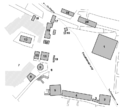Agora ateńska


Agora ateńska – najsłynniejsza agora znajdująca się w Atenach w starożytnej Grecji.
Usytuowano na niej świątynie, biblioteki i budynki użytku publicznego. Charakterystycznymi budowlami były stoa, czyli zadaszone kolumnady, które chroniły przed deszczem lub słońcem. Agora mieściła się u podnóża stromego, skalistego wzgórza – Akropolu. Działały tu najważniejsze państwowe urzędy, kupcy oferowali swe towary, odbywały się uroczystości publiczne.
Miejsce, w którym powstała, zostało wybrane jeszcze w czasach Solona (około roku 600 p.n.e.)[1]. Był to nieregularny plac o lekkim nachyleniu, co zapewniało naturalny odpływ wody deszczowej, przy głównej drodze wiodącej na Akropol. Otoczenie było zdatne do zabudowy, sąsiadujące ze strefą mieszkalną Aten.
W okresie klasycznym Agora ateńska była miejscem handlu, a także wielkich zgromadzeń mieszkańców i debat politycznych. W tym miejscu odbywały się wybory urzędników i sądy skorupkowe (ostracyzm), wystawiano (zanim wzniesiono stały teatr Dionizosa na południowych stokach Akropolu) sztuki teatralne, a także organizowano zawody sportowe[1].
Budowle wokół agory wznosili Kimon (V wiek p.n.e.), Likurg (IV wiek p.n.e.), władcy hellenistyczni (II wiek p.n.e.), a także Rzymianie: ostatnią monumentalną budowlą była biblioteka Hadriana z II wieku n.e.[1]
Splądrowana przez wojska Sulli w 86 roku p.n.e. uległa ostatecznej zagładzie podczas najazdu Herulów w roku 267 n.e.[1] Z biegiem czasu w miejscu dawnej agory powstawać zaczęła chaotyczna zabudowa miejska, którą wyburzono dopiero w latach sześćdziesiątych XX wieku, co pozwoliło wejść na teren archeologom i konserwatorom zabytków[1].
Aktualnie ateńską agorę dzielimy na tzw. Agorę Grecką i Agorę Rzymską. W czasach nam współczesnych, Agora Grecka, w zrekonstruowanym budynku, zwanym Stoą Attalosa, na co dzień mieszczącym Muzeum Agory, gościła m.in. ceremonię rozszerzenia Unii Europejskiej w maju 2004. Z kolei Agora Rzymska bywa miejscem najbardziej eleganckich i oficjalnych, międzynarodowych wydarzeń kulturalnych, zwykle łączonych z koncertem, odbywanym na otwartej przestrzeni terenu archeologicznego.
Budynki i konstrukcje na Agorze Greckiej
- Budynek sądu
- Mennica
- Studnia
- Stoa południowa
- Heliaia
- Strategeion
- Kolonos Agorajos
- Tolos
- Kamienie graniczne agory
- Pomnik herosów eponimów
- Stary buleuterion (Metroon)
- Nowy buleuterion
- Hefajstejon (Świątynia Hefajstosa)
- Świątynia Apollina Patroosa
- Stoa Zeusa
- Ołtarz Dwunastu Bogów
- Stoa Królewska
- Świątynia Afrodyty Urania
- Stoa Hermesa
- Stoa Poikile (Portyk Malowany)
Część północna agory (na planie u góry po prawej) nie została jeszcze w całości odkopana, ale zgodnie z przekazami autorów starożytnych znajdują się tam zapewne fundamenty stoi Hermesa i Poikile[2].
Przypisy
Bibliografia
- Encyklopedia sztuki starożytnej. Anna Derwojedowa, Andrzej Dulewicz, Bożena Grochala (red.). Warszawa: Wydawnictwo Naukowe PWN, 1998. ISBN 83-01-12466-0.
- N.G.L. Hammond: Dzieje Grecji. Warszawa: Państwowy Instytut Wydawniczy, 1973.
- W dawnych Atenach. Janina Kosińska, Krzysztof Plater (red.). Zakład Narodowy im Ossolińskich, 1971.
Media użyte na tej stronie
Autor: Michael F. Mehnert, Licencja: CC BY-SA 3.0
A train of Athens-Piraeus Electric Railways passes the Stoa of the ancient Agora.
Autor: User:Madmedea, key corrected by User:LlywelynII, Licencja: CC BY-SA 2.0
Plan of the ancient agora of Athens c. 5th century BC.
Key
- 01 Square Peristyle, probably used as a courthouse & surrounded by vendors. Built early 4th c. BC, demolished c. 150 BC.
- 02 Mint, used for Athens's bronze coinage. Built c. 400 BC, destroyed c. 1st century.
- 03 SE Fountainhouse, misidentified by Pausenias as the Nine-Spouted Fountain (Enneakrounos). Built c. 525 BC.
- 04 South Stoa I. Built c. 425 BC, dismantled mid-2nd c. BC.
- 05 Aiakeion, dedicated to the Aeginan hero Aiakos, used as a granary & for the display of legal decisions. Formerly misidentified as the Heliaia. Built early 5th c. BC by order of the Pythia of Delphi.
- 06 Strategeion, dedicated to the hero Strategos, used as the meeting house of Athens's 10 generals (strategoi). Built mid-5th c. BC.
- 07 Stone benches of Agora Hill (Kolonos Agoraios). Built late 5th c. BC.
- 08 Tholos. Also known as the Skias from its supposed resemblance to a straw hat. Also known as the Prytanikon or Prytaneion as the home of the Prytany. Built c. 470 BC.
- 09 Boundary stone, marking one entrance to the agora. Erected c. 500 BC.
- 10 Monument of the Eponymous Heroes, the namesakes of the Athenian democracy's 10 tribes, chosen by the Pythia of Delphi. Present structure built late 4th c. BC.
- 11 Metroon, the Old Bouleuterion, dedicated to Cybele in propitiation after the Plague of Pericles was attributed to the murder of one of her missionary priests. Present structure built mid-2nd c. BC.
- 12 New Bouleuterion. Built late 5th c. BC.
- 13 Hephaistion or Theseion, the temple of Hephaestus & Athena the Worker (Athena Ergane), decorated with events in the lives of Hercules & Theseus. Built late 5th c. BC.
- 14 Temple of Fatherly Apollo (Apollo Patroos), honoring his siring of Ion, eponymous forefather of the Ionian Greeks. Built late 4th c. BC.
- 15 Stoa of Free Zeus (Zeus Eleutherios), honoring his help in defeating the Persians at Plataia & decorated with the shields of Athenians fallen in battle. Built late 5th c. BC.
- 16 Altar of the Twelve Gods, sanctuary. Built early 6th c. BC, dedicated 521 BC.
- 17 Royal Stoa (Stoa Basileios), seat of the royal archon (archon basileus), public copies of the city's laws, & the oath stone used to swear in new officials. Built c. 500 BC.
- 18 Temple of Heavenly Aphrodite (Aphrodite Urania). Built late 6th c. BC.
- 19 The Painted Stoa (Stoa Poikile), depicting Athenian victories in paintings & captured arms. Built early 5th c. BC.
- 20 A former mistaken location of the Painted Stoa used when 19 was mistakenly assumed to be the Stoa of the Herms.
Autor: https://www.flickr.com/people/jonezes/, Licencja: CC BY-SA 2.0
View of the ancient agora of Athens, showing temple of Hepaestus to the left and the rebuilt Stoa of Attalos.



